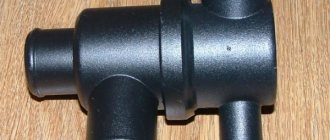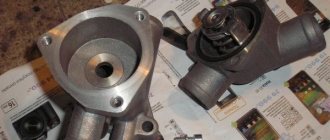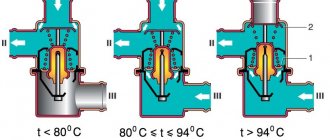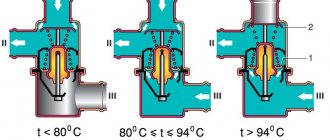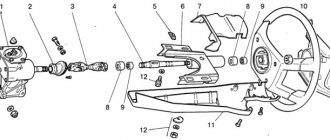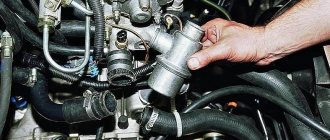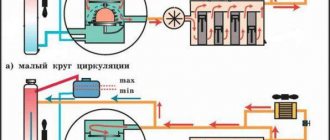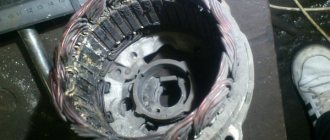What is a thermostat for?
The thermostat is necessary to maintain the coolant temperature within the operating range. In simple words, a thermostat is a valve that shuts off and opens the flow of coolant through the cooling radiator.
The operating temperature of the engine is from 80 to 95 degrees, this temperature is considered normal, and a working thermostat maintains exactly this coolant temperature. When the thermocouple is faulty, the temperature becomes less or much more than expected, which can even lead to engine failure.
Symptoms of a problem
You can judge whether the thermostat is malfunctioning by finding signs of a malfunction in your car, such as insufficient coolant temperature, that is, when driving on the highway or in the cold season, the antifreeze temperature begins to drop rapidly or does not rise to operating temperature at all.
It should be noted that if the engine overheats, the reason may be not only the thermostat, but also the breakdown of the water pump blades.
Reviews from Chevy Niva owners
Alexey Bondarenko, Kazan
For a year now I have been driving with a WEEN thermostat, article number 181-0034. The device turns on at a temperature of 87°C. My first thermostat was also a WEEL brand. I traveled with him for less than a year. He stopped maintaining his temperature. I've had my current device for one year and a summer. There were never any problems. The temperature always stays between 85-92 degrees.
Maxim Kalashnik, Pskov
I have been operating a VAZ Chevrolet Niva for more than 10 years with a Thomson thermostat. I have no complaints about the thermostat. Its peculiarity is that thermal inserts work for about 2 years in normal mode. Then they begin to underestimate their indicator. The standard temperature for them is 81°C. In the summer they work fine, that is, 87°C, and in the winter it feels a little cool at 81°C.
Examination
The check can be done without removing the part from the car. To do this, start the cold engine and wait until it warms up to operating temperature. During warming up, we touch the lower radiator pipe several times and evaluate its temperature. Before the car reaches operating temperature, the lower pipe must be cold; if it warms up at the same rate as the other pipes, then the thermostat is faulty and is stuck in the open position.
Lada 2106 › Logbook › Thermostat from Shniv to Classic
The main radiator was welded in two places... The heater radiator was not touched, the reason was trivial, the tap was not opened all the way (damn Luzar). And at the same time I bought a thermostat from Shnivy. There was little choice, Luzar or VAZ. Having bitter experience of working with the Luzar company, I took the VAZ, although it was almost 200 rubles more expensive. What you need: 1) Chevy Niva thermostat 2) Several Zhigulevsky pipes coming from the standard thermostat 3) A pipe with a diameter of 18 mm and a length of 1 m 4) I don’t remember the diameter of the tube, but for the thinnest socket for a new thermos 5) A bunch of clamps of different sizes (just don’t take the above-mentioned company like this, because of them everything was delayed.) 6) Antifreeze about 10 liters 7) Two bolts or dowels (can be bought at any plumbing store) Straight arms and comrade (with beer) Let's get started: Drain the antifreeze. We remove all the pipes (the entrance from the head to the stove can be left untouched). Next, we plug the two outlets from the pipe running from the pump to the stove. I plugged it simply: on one socket, which was larger in diameter, I put a pipe that went to the stove, cut it and put a plug, tightened it with a clamp, and in the second, which was used to heat the carburetor, I screwed in a bolt and also tightened it with a clamp. Next we set up the thermostat. First you need to mount the pipe coming out of the radiator. We took the old one and unfolded it, for example, a part that was worn out on the radiator is now put on the thermostat and cut off by 5 cm, now the thermos rotates as it should and rises a little higher. The old tube going from the thermos to the pump is short, so we cut the purchased one so that we get a straight section without bends, 10 cm. The upper one, which is at the head, can be left alone. Next, we measure and cut a thin tube, it will go from the manifold to the thin thermostat outlet. We also measure an 18 mm pipe from the outlet of the stove to the left one on the thermostat (they took it with a reserve, the joint turned out to be large, and the pipe was bent in one place, but not tied to it with reference to the body). At this point the installation process is completed, you can tighten the clamps. Well, we fill in antifreeze and let out all the air)) I took it out like this: I disconnected the hose from the manifold and the 18 mm hose going from the stove to the thermos from the thermos side. Open the stove tap. Through the funnel we begin to pour antifreeze into the stove pipe. As soon as the antifreeze has drained from the thermostat, insert the pipe into which it was poured and tighten it with a clamp. Then pour it into the radiator. As soon as it comes out of the manifold, we put the remaining pipe there. We start it and fill it into the radiator, keep the number of revolutions at 3-4 thousand... Impressions: On the old thermostat, even with a tamper + outside it had time to cool down, and the fan turned off every 10 seconds while heating. Now the engine has quickly warmed up to operating temperature, it’s already -5 and the wind has died down, the cooling doesn’t turn on, it’s Tashkent in the cabin, my fingers are burning)). I'm happy with the word)) I'll finally check it in winter))
And at the same time I bought a thermostat from Shnivy. There was little choice, Luzar or VAZ. Having bitter experience of working with the Luzar company, I took the VAZ, although it was almost 200 rubles more expensive. What you need: 1) Chevy Niva thermostat 2) Several Zhigulevsky pipes coming from the standard thermostat 3) A pipe with a diameter of 18 mm and a length of 1 m 4) I don’t remember the diameter of the tube, but for the thinnest socket for a new thermos 5) A bunch of clamps of different sizes (just don’t take the above-mentioned company like this, because of them everything was delayed.) 6) Antifreeze about 10 liters 7) Two bolts or dowels (can be bought at any plumbing store) Straight arms and comrade (with beer) Let's get started: Drain the antifreeze. We remove all the pipes (the entrance from the head to the stove can be left untouched). Next, we plug the two outlets from the pipe running from the pump to the stove. I plugged it simply: on one socket, which was larger in diameter, I put a pipe that went to the stove, cut it and put a plug, tightened it with a clamp, and in the second, which was used to heat the carburetor, I screwed in a bolt and also tightened it with a clamp. Next we set up the thermostat. First you need to mount the pipe coming out of the radiator. We took the old one and unfolded it, for example, a part that was worn out on the radiator is now put on the thermostat and cut off by 5 cm, now the thermos rotates as it should and rises a little higher. The old tube going from the thermos to the pump is short, so we cut the purchased one so that we get a straight section without bends, 10 cm. The upper one, which is at the head, can be left alone. Next, we measure and cut a thin tube, it will go from the manifold to the thin thermostat outlet. We also measure an 18 mm pipe from the outlet of the stove to the left one on the thermostat (they took it with a reserve, the joint turned out to be large, and the pipe was bent in one place, but not tied to it with reference to the body). At this point the installation process is completed, you can tighten the clamps. Well, we fill in antifreeze and let out all the air)) I took it out like this: I disconnected the hose from the manifold and the 18 mm hose going from the stove to the thermos from the thermos side. Open the stove tap. Through the funnel we begin to pour antifreeze into the stove pipe. As soon as the antifreeze has drained from the thermostat, insert the pipe into which it was poured and tighten it with a clamp. Then pour it into the radiator. As soon as it comes out of the manifold, we put the remaining pipe there. We start it and fill it into the radiator, keep the number of revolutions at 3-4 thousand... Impressions: On the old thermostat, even with a tamper + outside it had time to cool down, and the fan turned off every 10 seconds while heating. Now the engine has quickly warmed up to operating temperature, it’s already -5 and the wind has died down, the cooling doesn’t turn on, it’s Tashkent in the cabin, my fingers are burning)). I'm happy with the word)) I'll finally check it in winter))
Thanks to BooSHiK for your help in installing this miracle)) And to the guys who went shopping for clamps and other crap))
There are no photos of the process itself, cold on the street and dirty hands, who won’t understand what will be asked of them
Types of thermostats
The standard Niva thermostat is a fairly reliable element and serves faithfully for a very long time. The opening temperature of the factory thermoelement is 85⁰С, which is not enough for the stove to operate efficiently in cold weather. There are a huge number of analogues of the factory thermostat, and one of them is a thermocouple with a large circle opening temperature of 92⁰C, which will allow the internal combustion engine to operate at higher temperature conditions and will make the interior heater work much more efficiently, which will not affect the operation of the internal combustion engine.
Source
Thermostat for Niva Chevrolet
Correct operation of a car engine is ensured by a combination of factors that must be constantly monitored, maintaining the necessary modes on the accompanying units.
One of the important indicators is the temperature of the coolant, which directly affects the speed of warming up the engine and the removal of excess heat from it. As in any other car, in the Chevrolet Niva, control of the parameter is assigned to the thermostat. This device, to a certain degree of temperature increase, maintains the circulation of coolant in a small circle, facilitating engine warm-up. When the antifreeze reaches 80–90 °C, the regulator automatically changes the exchange to a large circle, which includes a cooling radiator. The latter prevents the antifreeze from boiling and ensures that its temperature is maintained within the limits of the norms for correct heat removal from a running engine.
The thermostat itself on the Chevrolet Niva is mechanical. There are no third-party connections to it, except for the incoming and outgoing pipes of the cooling system.
Which manufacturers of thermostats for Chevrolet Niva should you trust and how to replace them yourself?
Thermostat is a device in the engine cooling system that automatically regulates the temperature of the coolant.
The device maintains optimal thermal operating conditions of the engine; with its help, the engine warms up faster.
Structurally, it is a valve, inside of which there is a heat-sensitive element that blocks the flow of water, antifreeze, antifreeze through the radiator until the engine is completely warmed up.
Installation location: in Chevrolet Niva it is located on the left front edge of the engine, connecting the lower pipe of the stove, pipes from the radiator, engine and throttle valve.
How to check
There are two methods for checking the functionality of the regulator, depending on whether a thermostat is installed in the car or not. If the unit is already connected to the engine and while warming up, the upper pipe going to the radiator immediately becomes hot, the exchange device is not working properly. The same applies to the case when the engine is warmed up, but the “large circle” line remains cold.
Another test method is used when the thermostat is disconnected from the vehicle systems. If low pressure air is supplied through the inlet pipe, it should not come out of the top of the thermostat. Only at the bottom. A violation of the current current directly indicates a faulty unit.
How to check the thermostat on a VAZ 2115, is it working?
How to check the thermostat of a VAZ 2115 - Automaster
- Start the engine, then wait two minutes.
- Touch the hose directed from the device being tested to the radiator.
- If the hose is hot, the device is faulty; most likely, the valve never closes.
Interesting materials:
How to set the time on your Jet Kid watch? How to set the time on a Huawei smartwatch? How to avoid blinking while putting on lenses? How not to get tired while studying? How to avoid logging into VK for a long time? How to treat strawberries with boric acid during flowering? How to form the future tense of a verb? How to form present participles? How is the Future Simple formed? How are short passive past participles formed?
Symptoms of the problem and consequences
The main signs of a malfunctioning thermostat in a car are abnormal coolant temperatures when the engine is running. It may be too high when the radiator fan is working correctly and there is a sufficient amount of antifreeze itself, or too low when the engine is warm. A concomitant sign of the last symptom is a sharp jump in coolant temperature when the engine stops.
Valve malfunction can also be monitored by the behavior of the temperature sensor when the machine is moving. When the speed increases, it shows values below normal, and when it decreases, on the contrary, higher.
A thermostat failure on a Niva reduces the service life of the motor and its final operating life, accelerating the wear of mechanisms due to constant overheating.
Unit design and reasons for failure
The Niva-Chevrolet thermostat is unified with all modern LADA car models. The basis of its operation is a mechanical system with a heat-sensitive element. While the latter is not sufficiently heated from the antifreeze, the flow of the coolant is limited to a “small circle” from the engine with its simultaneous return to it. As soon as the wax, which acts as a defining element, warms up in the thermostat, the internal piston will block the pipe coming directly from the engine, and the mechanism itself will open the flow of coolant from the radiator.
There are two main reasons for the failure of this system. The first is the ingress of dirt particles into the mechanism itself and the second is wear and tear of the wax valve over time. Regardless of what happened, it is recommended not to repair the unit, but to completely replace it.
TOP thermostat models
The list of thermostat manufacturers for Niva is quite large. The average price level for a device is around 500 rubles. Based on reviews, the most popular models for 2020/early 2021 will be:
| Manufacturer | vendor code | Price |
| Lugar | LT 0123 | 540 |
| Lugar | LT 0124 | 660 |
| LADA | 21230-1306010-83 | 680 |
| Belmag | BM.0240 | 390 |
| Pilenga | Tt-P 4002 | 350 |
All thermostats from the listed manufacturers are of the required level of quality and are recommended for purchase by many automotive professionals. It is difficult to determine which is better from the list. All of them interact well with the standard Chevy Niva engine cooling system, passing related tests for trouble-free operation.
Manufacturers and types
Standard sizes of thermostats, which by their design are suitable for installation in the engine of a Chevrolet Niva car, are produced by a number of global companies. The table below presents a list of products.
| Model | Product serial number | Opening temperature |
| Thomson | 21230-1306010-05-0 | 80° |
| Zommer | 2123-1306010 | 80° |
| Metal Inkar | 2123-1306010-01 | 80° |
| Pramo | 2123-1306010-02 | 80° |
| WEEL | 182-0114 | 80° |
| Luzar | LT0123 | 80° |
| Herzog | HL36010 | 80° |
| Vkt | VT29003 | 80° |
| Fenox | TS009E7 | 80° |
| Finord | 21231306010 | 80° |
| Baker | 21231306010 | 80° |
| Finwhale | FinwhaleT123 | 80° |
| Gallant | GLTH14 | 80° |
| Hofer | HF 445 730 | 80° |
There is an opinion among car owners that the highest quality, reliable and durable thermostats are products produced by Russian factories. There are currently three such enterprises:
Among foreign models, car owners have good reviews of the Metal Inkar model from the Polish manufacturer.
These products work great in the Chevrolet Niva cooling system, the engine warms up quickly, there are no complaints.
The only negative is that the body is made in two versions - plastic and brass. The second option is not very popular among drivers, although it also works well in a circuit.
Zommer, Luzar, WEEL thermostats should only be selected from approved manufacturers. There are a lot of fakes on the market and on the Internet. Retailers seek to sell their dubious products under the guise of original ones to newcomers in the automotive business. To avoid getting burned, when purchasing, you must require licenses, certificates and supporting documents from sellers.
Replacement
Before removing the thermostat, it is imperative to lower the antifreeze level. The disassembly itself is carried out on a cold engine to avoid burns from the hot coolant.
The regulator is attached to the cooling system with sealing clamps on each of the five supply pipes. The unit is dismantled by unscrewing them.
After installing the new thermostat, the fasteners return to their original place. Before replenishing the antifreeze level, disconnect the cooling system pipe leading to the engine throttle assembly. The latter is done to bleed off excess air when filling the liquid.
Replacing the thermal switch
The thermostat is replaced if the engine's thermal conditions are violated. This usually happens after 60 thousand km. The replacement process is not difficult. It is not necessary to completely drain antifreeze or antifreeze from the system.
Important! When the pipes are disconnected, a certain amount of coolant spills out, so you need to buy it first to top it up.
Required materials and tools:
1.Loosen the screws on the five clamps, using a screwdriver, tightening the pipes.
2.Pull off the rubber pipes from the thermostat housing.
3.Remove the old thermostat.
4.Install the new device in reverse order. Before installation, lubricate the joint with sealant. Tighten the new clamp screws securely with a screwdriver.
Note! All thermostats used structurally for the Chevrolet Niva are unified and suitable for VAZ classics.
Modification of the thermostat
Some car enthusiasts modify the regulator, adding to it the ability to manually control the stroke of the piston, which controls the shutoff of the small circle pipe. For this purpose, a hole is made at the bottom of the thermostat housing and the thread is cut with a tap. A bolt is screwed in there, which subsequently, resting against the piston of the mechanism, will limit its movement when heated.
The system is adjusted with the engine in operating mode. The bolt is screwed in until the engine temperature on the dashboard reaches 90 °C.
If the walls of the thermostat are too thin, as for example with Lugar products, use an M5 threaded rivet instead of threading. The stroke of the bolt is limited by lateral rolling not only from above, but also inside the control device, so that it precisely hits the piston of the latter.
In the winter cold everyone is young. Thermostat…
I return to this topic about thermostats periodically. I follow the posts here on the drive and the topics on the shnivo forum. Usually everyone has a problem - the spare parts are rubbish and the thermostat is stuck in a small or large circle. Over the long history of ownership, I probably replaced 3-4 of them. I never considered it a breakdown - it took about an hour to fuss with replacement, without draining the coolant (or rather, draining about a liter). In August/September I encountered this issue once again - the summer heat passed and I noticed that the car was not heating up. I decided that everything was clear and went to the store. I bought a thermos from Ladaimage in a blue box. Inside was a Pramo set to 80 degrees.
The old one, which I thought was jammed in a large circle, turned out to be exactly the same Pramo at 80 degrees.
I changed it and was disappointed. The car doesn't heat up at all. Or rather, it only heats up to 80 degrees. At idle in warm weather you can wait for 84, but mostly 81. When driving around the city 80-81, in the worst traffic jams 85.
I went to the store to look for the truth. But she's not there. There is a Pramo in the box LadaImizhd 80 degrees. There is Pramo in the Pramo box, exactly the same. There was also a plastic Luzar, also 80 degrees.
The plastic Luzar seemed completely scary. The valve was blown without straining. The seller tried several pieces and everything was the same - the valve was not completely closed.
Pramo in the box Pramo was not blown through at all. And the choice fell on him.
I decided to boil it at home as advised. I threw a thermos and a thermometer into the water. And he began to wait - at 46 degrees the first drops began to appear. It began to flow like a stream at 80. It reacts adequately to cold water - it closes well.
I also checked the old one - everything is the same. Opens/closes.
I decided to look further because I couldn’t heat it up. And so a friend told me that there is a winter thermostat. I don't know what this is, but I can order it. So I fought back in the catalogue. Ordered - 450 rubles. It's ok for an experiment.
I have never dealt with such parts before.
He compared it this way and that, twisted it, blew it, cooked it, poured it with cold and hot water one by one, and Pramo and Hofer. Blowing showed that the hofer does not close tightly. It doesn't blow much, but it always does. The boiler said it opens at 85, but before that it always drips.
There are no complaints about the quality of production. The fittings have small notches and are painted. I didn't see any more difference. I decided to test it on the car. I replaced the working one a week ago with this experimental one. As expected, it has warmed up. The temperature is kept at 85, at idle it was possible to wait until 90. When driving 85. in a city with traffic jams 87-88. In general, I consider this mode to be comfortable, but I don’t know what will happen in the summer in the heat. Do not change winter/summer thermoses. I was thinking about adjustable one - there are two worker donors, maybe it’s worth a try.
Along the way, I replaced the Vagov tank (which never cracks). After 8 years, I also began to snot at the seams. I bought something similar - but the fittings are slightly in the other direction and the mount (ears) turned out to be wider. I'll have to sculpt another bracket - for now I've attached the standard one to an elastic band.
While I was ordering thermoses, the anti-freeze lid caught my eye on the tanks. Mine hasn't turned on for a long time. Maybe it was never screwed on at all - I just put the lid on and that’s it. The new one turned out to be convenient.
It is rubber and when opened it creates a funnel for accuracy.
When closed it does not interfere with anything. I like it. The fit on the neck of the tank was perfect.
Source
Lada 2107 ツ ツ ツ LADA RAZVOLUTION® › Logbook › ➀➅➀✍ Thermostat 2123 chevy niva…
I went, I went. The temperature with the stove open was always 80 degrees. When I close the stove a little by 2 degrees, it heats up. For winter this is not at all true. It also took a long time to warm up. I decided to change it before the severe frosts. Purchased from Chevrolet Niva.
I found in our country a Pramo type thermostat for 80 degrees, also a luzars, there is nothing else, the choice is off the charts))). The old standard lusar was also 80 degrees. The asking price for a new one is 300 rubles. I'll try something better later, if I'm lucky I'll bring it to 85 degrees.
Pipe from the stove tap.
I sawed off the pipe and hammered it in with a hammer.
I went to visit a friend, soldered it to a semi-automatic device and it turned out that it was such a plug.
The plug is in place instead of the tube. The plug is 2mm smaller at the edges than the standard tube. To install the studs, I drilled holes with an 8 mm drill. I took a paranitic gasket, covered it with sealant and screwed everything together. I stood up like a loved one.
I bought a set of injectors for the VAZ 2108 stove, the asking price is 200 rubles from the company, it’s not clear, but it says Balakovo. I took a long tube from the kit, on one side a 20mm tube directly to the tube in the thermostat, on the other an 18mm tube, a classic 16mm tube, for this I took an adapter tube from a gazelle 16mm to 18mm, and at the same time clamps.
To ensure that the thermostat becomes like its original one and does not cling to the lower pipe on the generator rod and there are no bends, it is necessary to extend the pipe from the pump body to the thermostat. I bought a set of new tubes. At the top is a standard tube, about 5cm long, at the bottom is a 9cm piece that I cut from an old tube. On the standard one, one piece is larger for the pump body, on the one that is cut smaller, so that it fits in the heat with a hairdryer and wears it.
The plug, thermostat and extension tube are in place.
The lower pipe to the radiator costs absolutely nothing and does not touch or bend anywhere.
I screwed a long tube with a side of 20mm to the thermostat, it rests against the riser of the receiver, just in case I wrapped it with electrical tape so as not to fray).
Connects via a figure eight with a diameter of 16-18 mm and a classic adapter tube. Cut each one a little in place so that the figure eight pipe does not fall on the fuse box and wires.
General view of what happened. The figure eight pipe does not touch or cling anywhere. More than 6-7 cm to the suction pipe. The pipe rests only on the spacer.
In the photo above you can see that the accelerator heating tube clings to the battery platform, but we don’t need this, since it wears out, so we made such a pipe holder temporarily). Now nothing sticks anywhere.
At the same time, I screwed the tap into the block to make it easier to drain the antifreeze.
Consequently. The temperature rose from 80 degrees to 84-85 degrees, ideally it would be nice to install a good pump with a large impeller and a DaAZ main radiator, and not a Luzar, well, that's a completely different story))). I’m driving with the heater tap open, outside it’s 0-4-15 degrees, the temperature in all modes, loads, speeds and gears is 84-85 degrees. With the tap closed on the stove, the temperature is 86-87 degrees under the same conditions. When standing, the car heats up to 90-95-100 degrees (Tashkent stove). When warming up, I didn’t notice whether it heats up the same or faster, it heats up by 10 degrees in 1 minute. I immediately took a set of stove pipes from the eight, so that they would be available if I suddenly decide to install an additional pump from the gazelle, I just need to look for a pump with 18 mm pipes.)
Replacing the thermostat.
Recently I began to notice that the coolant temperature arrow on the dashboard on a warm car shows 80-85 degrees no more
...and it’s even more interesting in a traffic jam in winter (it can creep beyond 90 degrees). After googling the Shniva forum, I discovered the reason... THERMOSTAT. Without hesitation, I decided to replace this “penny” part. In the Lada-Detal store, the thermostat Chevy Niva 2123-1306010 costs exactly 500 rubles (plus for the domestic auto garden - I bought a “thermos” the other day on a Pegeon - original Gates 1970 rubles. The difference is noticeable). In the LADA-do box there was a thermostat from the manufacturer T/A (Thomas Auto).
It didn’t take me long to choose a manufacturer (and there are at least 4 of them) because the manager in the store diligently assured me that it was really high quality + I checked everything right away in the old way - I blew into the “large circle” outlet - it doesn’t let through. Ok, let's take it. (I thought))) Then we google and understand that changing the thermostat yourself is as easy as shelling pears, having in your arsenal a minimal set of tools, a warm garage and a good friend)) We drove it into the garage, cooled it for about 20 minutes, removed the hose from the coolant tank, drilled it into the old one there was a hole in the lid of the coolant tank (the lid remained after replacing the coolant tank), they connected a car compressor through a hose to inflate tires (so as not to blow into the tank themselves) and “squeezed out” a couple of liters of antifreeze through the return line, then removed the hose supplying coolant to the throttle body and squeezed it out again grams 500. Next, calmly loosen the thermostat clamps, remove the old one and install the new one. Here is the new handsome guy
pull the clamps, fill in antifreeze, remove the hose supplying coolant to the throttle body to bleed the air, bleed the air, put it back on and tighten it.
Here he is an old man. I checked in the same way - I blew into the “large circle” outlet - it blows out easily. CONCLUSION - not working.
Source
